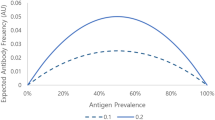Abstract
IN 1961 we reported the results of studies on a case of acute, iso-immune hæmolytic anæmia experimentally induced in a CwDe/Ce(R1wR1) volunteer transfused with plasma containing exceptional anti-CD antibodies1. Antibody sensitization of the recipient's erythrocytes was detected by the direct antiglobulin test (Coombs) up to day 133 following the plasma transfusion. Positive tests for antibody-coated red cells were obtained in the serum + albumin (a mixture of equal parts of human serum and 30 per cent bovine albumin) slide sensitization test through the 98th post-transfusion day. The study of the recipient's post-transfusion serum specimens for free, circulating antibodies in titration procedures employing serum + albumin revealed three distinct periods of antibody activity especially with the cDe/ce(R0R0) primary test cells. The first of these appearing between the first hour and the ninth post-transfusion day was interpreted as surplus antibodies remaining from those transfused in the anti-CD plasma, the second between post-transfusion days 14 and 98 as indicative of eluted or released antibodies and the final between days 105 and 140 as possible auto-immune antibodies representing the product of active immunization by the recipient himself. The peak titres of the free, circulating antibodies in the second and third periods of increased antibody activity were definitely higher than those obtained in the first, immediate post-transfusion one. In view of the Rh genotype of the recipient (CwDe/Ce), the serologic specificity of the transfused antibodies (anti-CD) and the observation that the antibodies in the third peak were reactive against the C and D antigens in the Rh system, no conclusive proof of the auto-antibody nature of these antibodies could be established on the basis of blood group specificity.
This is a preview of subscription content, access via your institution
Access options
Subscribe to this journal
Receive 51 print issues and online access
$199.00 per year
only $3.90 per issue
Buy this article
- Purchase on Springer Link
- Instant access to full article PDF
Prices may be subject to local taxes which are calculated during checkout
Similar content being viewed by others
References
Bowman, H. S., Brason, F. W., Mohn, J. F., and Lambert, R. M., Brit. J. Hœmat., 7, 130 (1961).
Author information
Authors and Affiliations
Rights and permissions
About this article
Cite this article
MOHN, J., LAMBERT, R., BOWMAN, H. et al. Production of Specific Anti-E Autoantibodies in Experimental Iso-immune Hæmolytic Anæsmia in Man. Nature 199, 705–706 (1963). https://doi.org/10.1038/199705a0
Issue Date:
DOI: https://doi.org/10.1038/199705a0
Comments
By submitting a comment you agree to abide by our Terms and Community Guidelines. If you find something abusive or that does not comply with our terms or guidelines please flag it as inappropriate.



